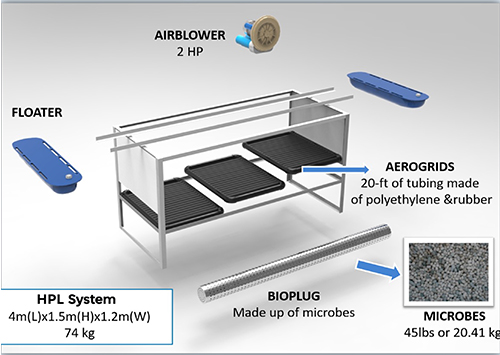
This technology is patented under wastewater treatment process based on Immobilized Bioreactor System (IBS) vide US Patent No. US 8,066,873 B2 dated November 29, 2011 titled “Floating Bioreactor System. The patented technology involves use of immobilized non genetically modified organisms (Non GMO) classified by the US Center for Disease Control and Prevention (CDC) as Biosafety Level 1
Made of injection molded HDPE plastic and comes with 66 feet of Aerotube aeration tubing attached using stainless steel clamps.
This Biotubes are filled with “media” that are immobilized microbes.
These are light weight and heavy duty bars that can be submerged in to almost any contaminant water.
These are composed of four sheets and are used to cover about 3/4th of the lift. This is to provide water direction and suction.
Made of PE plastic which provide buoyancy to the HPL System, making it mobile with less power.
A single phase 2 hp blower that uses 1.6kW of power. This motor transfers 145m3 air/hr. Approximately 3.65 kg O2/hr are transferred in to the surrounding water.
Project Done
Happy Clients
Award Winning
Rating Customer
The HPL system uses natural facultative anaerobic non-pathogenic micro-flora capable of performing well under both aerobic and anaerobic conditions.
This technology makes use of a combination of anaerobic and aerobic stages thereby reducing the aeration demand by more than 50% when compared to conventional treatment system, without need for installation anaerobic reactors with special reference to the effluents with low degradability and very low potential of biogas generation, thereby reducing the capital cost substantially.
The evaluation of the industrial scale installation on secondary sludge have shown that the microbe used in the HPL System are capable to liquefy the bacterial sludge leading to conversion to simpler components thus facilitating decomposition during treatment process and hence eliminating the need of sludge wasting to the tune up to 90%
Further, since the microbes being used in HPL System are capable of liquefaction of microbial sludge generated as part of treatment process, the nitrogen concentration in system goes up, thus eliminating the need of adding nitrogen as nutrient for microbes making it economically attractive solution especially for the industrial effluents where nitrogen content in the effluent stream is negligible
The combination of anaerobic-aerobic treatment with immobilized microbes has demonstrated reduction of biologically degradable COD and BOD to the tune of more than 90% and 95% respectively under varying operating conditions with different substrates, thereby making this technology suitable for wide spectrum of effluents generated from different types of process industries.
Since this technology if capable of liquefaction of sludge within the system, odour from the effluent treatment plants and the treated effluents is completely eliminated. The laboratory and bench scale evaluation has also demonstrated the application of this technology for nutrient removal (N & P) from the effluent for safe discharge to natural streams. Since the microbes used in this technology are immobilized, they are capable of regeneration and restabilizing the process, in case any unfavourable condition leads to temporary destabilization.